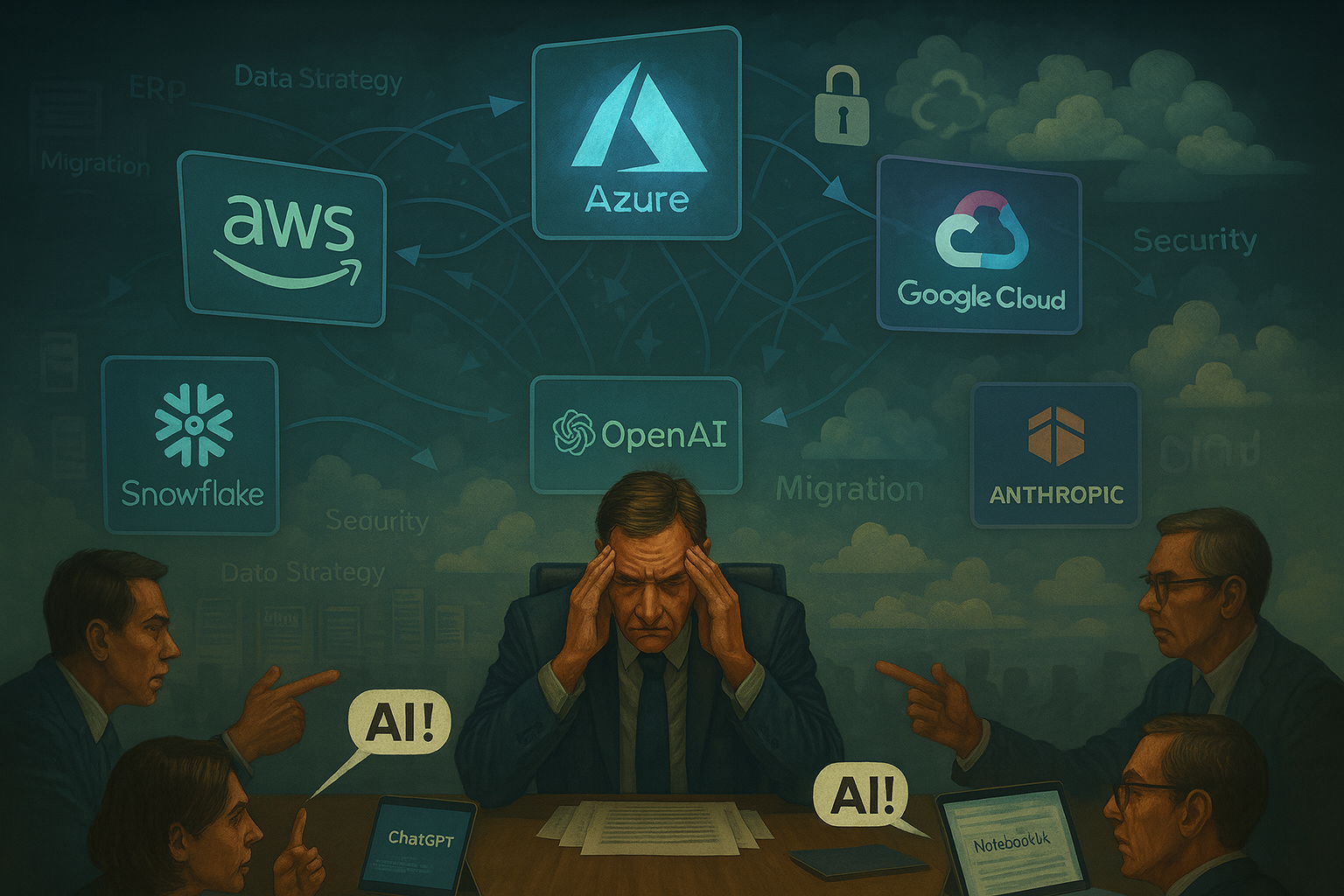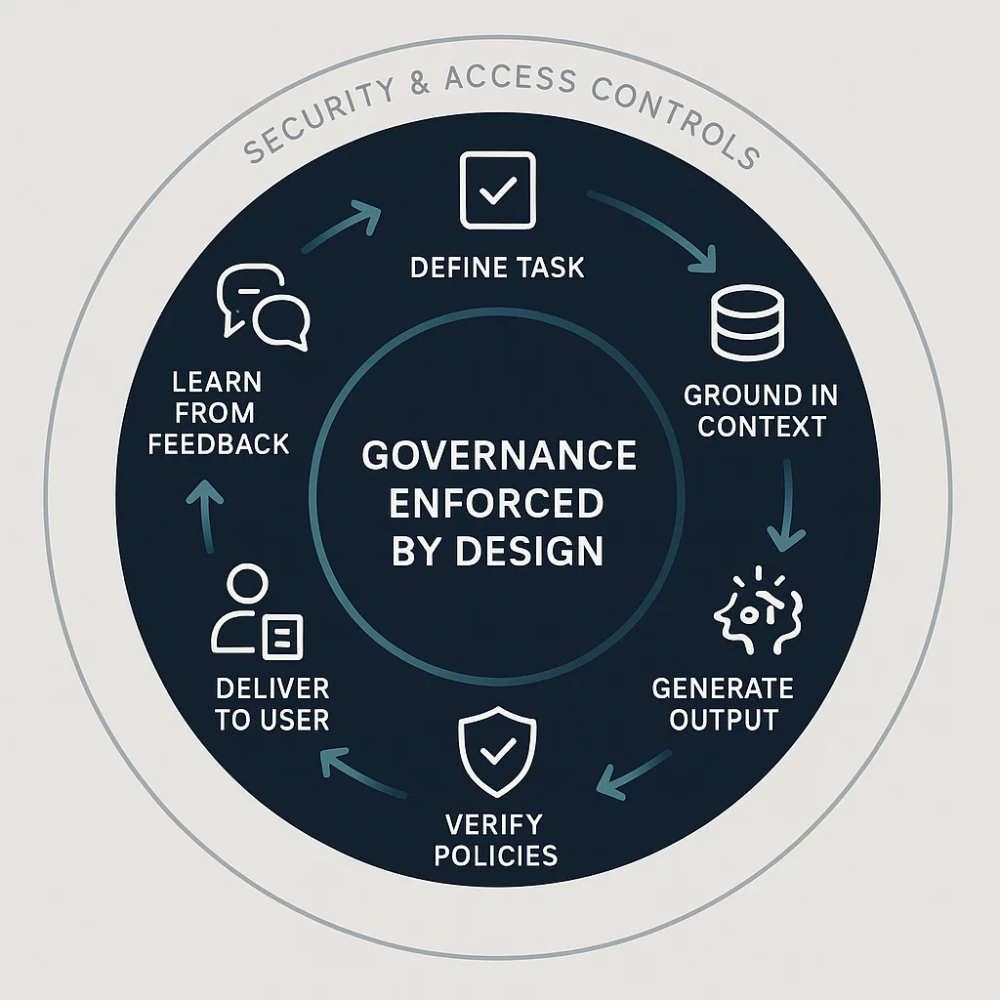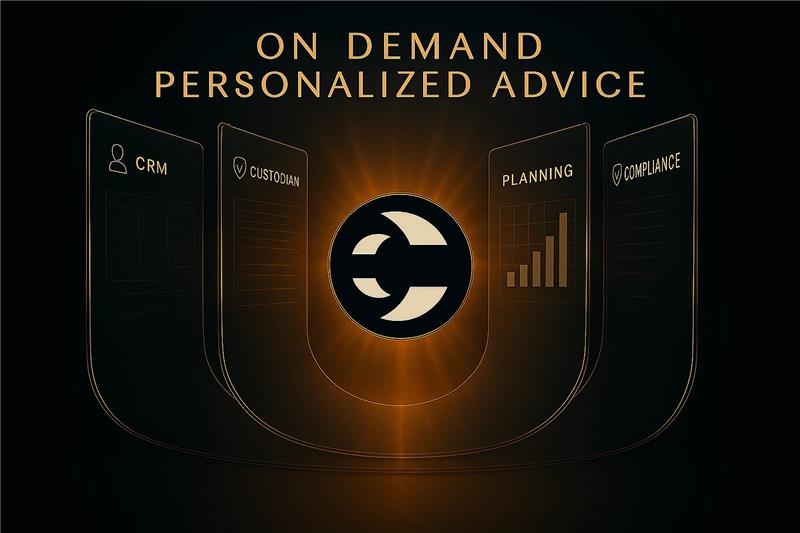The Trifecta Trap: Cloud, Data, and AI - All at Once

Why Mid-Sized Firms are Struggling with Transformation, and How to Escape with Confidence
By Suvrat Bansal (published on Linkedin
Executive Summary
Across boardrooms, a familiar frustration has set in: if AI feels so fluent in daily life, why is it so slow to adopt inside the enterprise?
CIOs and Chief Data & Analytics Officers know the reason. Most firms are still mid-migration to the cloud, bound by legacy systems, and stretched across overlapping vendor promises.
This creates a trifecta trap: organizations try to advance cloud, data, and AI strategies at the same time, but progress on all three stalls. Cloud providers bundle AI into their platforms. Data clouds steer workloads to their compute. Model providers push exclusivity that limits choice. Mid-market firms neither want multiple cloud/data/AI platforms, nor have the budgets to build and operate multiple ecosystems. The result is years of delay in achieving the Trifacta of cloud, data and AI strategy.
The way out is not choosing the “right” platform. It’s staying platform-agnostic, designing for choice, portability, and governance so no single vendor owns the path and your wallet.
We call this approach the AERO model: a four-layer architecture that separates AI, Experience, Resources, and Origin so each layer can evolve independently, yet still work together. AERO keeps enterprises from locking into a single stack, while making it possible to show results in 90 days.
1. The Trifecta Is Real — and It’s Slowing Transformation
Every CIO faces three journeys at once: cloud migration to AWS, Azure, or GCP; data modernization with Snowflake or Databricks; and AI pilots with copilots, agents, or retrieval systems. Each is difficult alone. Together, they overwhelm budgets and teams.
Checklist: Signs You’re Caught
· Competing “AI partnership” offers from multiple vendors
· Business units asking why AI “can’t just read the data” they already use
· Cloud and data projects absorbing most discretionary budget
· Pilots stalling for lack of context, governance, or feedback
In many portfolios, these tracks consume 70–80% of discretionary capacity — leaving little room to make AI succeed.
2. The Platform-Centric Pitfall
Vendor incentives are not neutral — they deepen the trap. Cloud providers like AWS, Azure, and Google bundle AI features but only if you bring your data to them. Data platforms such as Snowflake and Databricks promote alliances with OpenAI or Anthropic but route workloads to their own compute. Model vendors — from OpenAI to Meta to open source — often trade exclusivity for access, narrowing your options over time.
The result is predictable: lock-in, higher costs, compliance risk, and ROI postponed until migrations are finished.
Working with these players is unavoidable; depending on any one of them to define your future is the danger. Platform-agnostic does not mean spreading workloads across every cloud. It means designing so models, compute, and data access can shift as needed — without rewriting the business.
If the disease is bundled incentives, the cure is layered independence.
3. AERO: A Decoupled North Star
AERO is that independence. It is not another platform to buy, but an architectural compass: keep each layer distinct, so no vendor owns the full stack.
· AI Layer (A): where intelligence happens — models, retrieval, reasoning, agents. Swap models without rewriting workflows.
· Experience Layer (E): where people connect — briefs, copilots, dashboards, podcasts. Deliver outputs in the form each role needs.
· Resources Layer (R): where work runs — compute, orchestration, scaling. Orchestrate workloads across clouds without disruption.
· Origin Layer (O): where truth lives — SaaS apps, data warehouses, on-prem systems. Query data in place instead of duplicating it.
AERO is a runtime architecture for outcomes: swap-first, zero-copy by default, governed at the output. AERO is not a re-platforming or multi-platforming plan.
The distinction is clean: AI is where intelligence happens, Experience is how it’s consumed, Resources is where it runs, and Origin is where truth resides.
4. AERO’s Operating Model – Purpose-Built AI Agents
AERO becomes visible through agents: small programs configured for a purpose. To avoid becoming brittle copilots, agents need to be configured without compromising with governance, security and scale considerations.
Each agent cycles through a closed loop: define the task, ground in curated context, generate outputs, verify against policies, deliver to the user, then learn from feedback. Security and access controls apply throughout.
Each runs on curated context, governed policies, structured feedback, and secure access. Outputs only release when verification checks pass — governance enforced by design, not deferred to policy decks.

5. A 90-Day Playbook
Boards don’t want roadmaps. They want proof. With AERO, firms can show it in a quarter.
1. Pick 2–3 measurable outcomes. Examples: drafting a loan memo for credit officer, preparing a market and portfolio brief for financial advisor, publishing a five-minute product education podcast for insurance sales.
2. Stand up AERO – AI Layer – learn from data, develop context; Experience – engage beneficiary early, iterate fast; Origin - read data at source; Resource - scale based on scope; Governance & Security - embedded from beginning.
Detailed Build List:
· 3–5 data connectors (no migrations required)
· One orchestration engine
· One primary + one backup model (most times not needed)
· A minimal policy/evaluation harness
· UX layer with 1–2 role-specific outputs
3. Measure and document results. Track time-to-first-draft, revision cycles, user satisfaction, and compliance alignment.
By Day 90: deliver two role-specific outputs, provide lineage-stamped examples, produce a sample policy log, and compare before/after time/cost savings.
Run a parallel track with Data/AI Governance and Infosec - data masking, data quality, entitlements, and risk checks - to ensure no surprises later.
Proof comes from results, not promises.
6. Risk, Compliance & ROI You Can Ship
Neither users nor executive leaders will not tolerate black-box AI. If outputs cannot be explained, they won’t be trusted. If costs cannot be managed, they won’t be scaled.
Guardrails must therefore be embedded from the start. They prevent leaks and misuse, assure boards and regulators that outputs are controlled, and provide an audit trail that makes every answer defensible.
Every answer is explainable and traceable record instead of a black box. User engagement must be fast and should be measured -
Risk Stoplight:
· Green: safe to automate and scale
· Amber: requires review and refinement of data, context or results
· Red: use case not applicable or workflow must be redesigned before rollout
Risk stoplight framework ensures AI isn’t disengaged. Green-zone outputs can scale freely. Amber-zone outputs demand work before moving forward. Red-zone outputs must be either stopped or redesigned before they create hidden losses.
This discipline gives boards confidence that adoption is tied directly to ROI, not hype.
7. Anti-Patterns to Avoid
· Move or prepare all data before starting AI
· Treat AI as a purpose agnostic capability
· Bet everything on one model
· Pilot without business engagement or evaluation
· Ignore governance and security considerations at the beginning
Avoiding these patterns protects both flexibility and credibility.
Conclusion: Decouple to Deliver
The cloud–data–AI trifecta doesn’t have to be a trap. With AERO Operating Model, embedded Governance & Security, and iterative purpose driven rollouts, firms can:
· Demonstrate AI ROI in 90 days
· Govern every answer from the start
· Keep options open for the future
The message to boards: you don’t need to finish cloud and data migrations before showing AI impact. You need a platform-agnostic, governed approach that delivers value now and scales responsibly later.
Don’t reorganize for a platform. Organize for choice. That is how you escape the Trifecta dilemma and lead with confidence.



.avif)

